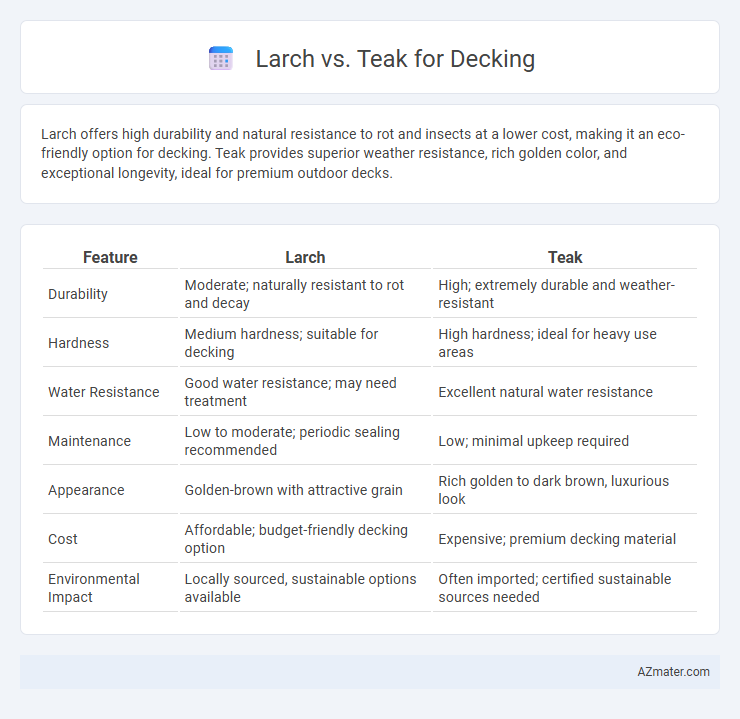Larch offers high durability and natural resistance to rot and insects at a lower cost, making it an eco-friendly option for decking. Teak provides superior weather resistance, rich golden color, and exceptional longevity, ideal for premium outdoor decks.
Table of Comparison
| Feature | Larch | Teak |
|---|---|---|
| Durability | Moderate; naturally resistant to rot and decay | High; extremely durable and weather-resistant |
| Hardness | Medium hardness; suitable for decking | High hardness; ideal for heavy use areas |
| Water Resistance | Good water resistance; may need treatment | Excellent natural water resistance |
| Maintenance | Low to moderate; periodic sealing recommended | Low; minimal upkeep required |
| Appearance | Golden-brown with attractive grain | Rich golden to dark brown, luxurious look |
| Cost | Affordable; budget-friendly decking option | Expensive; premium decking material |
| Environmental Impact | Locally sourced, sustainable options available | Often imported; certified sustainable sources needed |
Introduction: Larch vs Teak for Decking
Larch and teak are popular choices for decking due to their durability and aesthetic appeal. Larch offers natural resistance to rot and insects, making it a cost-effective option with a warm, reddish hue that deepens over time. Teak, known for its high oil content and dense grain, provides superior weather resistance and a luxurious golden-brown color that ages gracefully to a silver patina.
Wood Characteristics: Larch and Teak Compared
Larch wood is known for its high density and natural resistance to decay, making it a durable choice for decking with a slightly rough texture and warm reddish-brown hue that weathers to a soft silver-gray over time. Teak offers exceptional water resistance and rich golden-brown color due to its natural oils, providing superior durability and smooth texture ideal for outdoor environments where moisture and insects are concerns. Both woods are valued for decking, but teak's higher oil content ensures longer-lasting protection against elements, while larch offers a more budget-friendly, sturdy alternative with moderate decay resistance.
Durability and Longevity
Larch wood offers high natural durability with resistance to rot and insect attacks, making it suitable for outdoor decking in moderate climates. Teak exceeds larch in longevity due to its dense grain and natural oils that provide superior water resistance and protection against decay for decades. Choosing teak for decking ensures a longer lifespan with minimal maintenance in harsh weather conditions, whereas larch provides a cost-effective, durable option that may require more frequent treatment.
Resistance to Weather and Decay
Larch wood exhibits strong natural resistance to weather and moderate decay resistance, making it suitable for outdoor decking in temperate climates. Teak, renowned for its exceptional durability, offers superior resistance to moisture, decay, and insect attacks due to its high natural oil content, ensuring longevity in harsh weather conditions. Choosing teak results in lower maintenance and longer-lasting decks under severe weather exposure compared to larch.
Maintenance Requirements
Larch wood requires regular sealing and staining to maintain its durability and resistance to weathering, as it is moderately susceptible to rot and insect damage. Teak, known for its natural oils and dense grain, demands minimal maintenance, often only requiring occasional cleaning to preserve its rich color and prevent surface dirt accumulation. Choosing teak for decking ensures a longer lifespan with lower upkeep, while larch demands more frequent interventions to maintain structural integrity and appearance.
Appearance and Aesthetic Appeal
Larch wood boasts a warm golden hue with prominent grain patterns that deepen to rich amber tones over time, creating a natural rustic charm ideal for traditional decking. Teak offers a smooth, silky texture with a luxurious golden-brown color that weathers gracefully into a sophisticated silver-gray patina, enhancing its modern appeal. Both woods provide distinct aesthetics, with larch emphasizing rugged natural beauty and teak delivering an elegant, classic look that elevates outdoor spaces.
Environmental Impact and Sustainability
Larch wood is a sustainable option for decking due to its fast growth rate, natural resistance to decay, and certification availability under schemes like FSC, ensuring responsible forest management. Teak, while highly durable and water-resistant, often involves ethical concerns because of illegal logging and slower growth in natural forests, which can lead to deforestation and biodiversity loss. Choosing larch over teak reduces environmental impact by prioritizing renewable resources and minimizing carbon footprint through local sourcing and lower pesticide use.
Cost Comparison
Larch decking typically costs between $4 to $7 per square foot, making it a more budget-friendly option compared to teak, which ranges from $15 to $30 per square foot due to its durability and exotic appeal. The lower price of larch is attributed to its abundance and faster growth rate, while teak's high oil content and resistance to decay justify its premium price. Homeowners seeking affordable, sturdy decking often choose larch, whereas those prioritizing longevity and a luxurious finish invest in teak despite the higher initial cost.
Installation and Workability
Larch timber offers straightforward installation due to its consistent grain and moderate hardness, allowing easier cutting and fastening with standard tools. Teak is denser and oilier, which can complicate nailing and screwing, often requiring pre-drilling and specialized fasteners for secure installation. Both woods provide durable decking options, but larch's workability reduces labor time while teak demands more precise handling for optimal results.
Which is Better for Your Decking Project?
Larch wood offers excellent durability and natural resistance to decay, making it a cost-effective choice for outdoor decking projects, especially in colder climates. Teak is highly prized for its exceptional weather resistance, rich golden hue, and oily grain that repels water and insects, providing unmatched longevity and minimal maintenance. For decking, teak is better suited for premium, long-lasting installations, while larch is ideal for budget-conscious projects needing strong structural performance.

Infographic: Larch vs Teak for Decking
 azmater.com
azmater.com